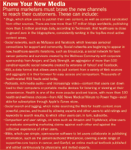Web 2.0—Consumers on Demand
For pharma marketers, understanding the on-demand opportunity starts with recognizing that customers are, in many ways, ahead of the industry
Pharma marketers' biggest opportunity today lies not in generating demand, but in servicing the demands of the 160 million health-information seekers already online.

Larry Mickelberg
Search engines, such as Google, Yahoo!, and MSN, have become the de facto starting point for both consumers and healthcare professionals looking for health information. According to Manhattan Research, more than 7 million searches for health information are conducted each day—nearly 3 billion per year. Two out of three patients turn to the Internet both before their doctor visits (to research their condition and prepare questions) and afterwards (to validate what their doctor has told them and find answers to questions they didn't ask).

Bruce Grant
Customers have already identified themselves by their search-engine usage and the sites they visit. The challenge for marketers is to engage them and earn their trust by connecting them with helpful information and like-minded people—not just through Web sites, but through search results and a multiplicity of new channels. (See "Know Your New Medi".)
Though based on diverse technologies, all of the new health channels represent a shift of power from the large institutions that have traditionally controlled the brand dialogue (read: pharma companies) toward the users, powered by consumers' declining trust in marketers and rising trust in content created by their peers.
For pharma, understanding the on-demand opportunity starts with recognizing that its customers are, in many ways, ahead of the industry. Their expectations for service, value, and control have already been set by their experience with a wide range of non-pharma resources—and those expectations are high. Consumers' use of technology is, in general, more sophisticated and varied than most pharma marketers employ or even envision in their promotional strategy. And the high stakes that health conditions often carry incline consumers to mistrust companies they perceive as trying only to market to them (but conversely, they are highly loyal to companies they perceive as truly serving them). Thus, for key lessons, pharma marketers should look toward their customers, not their competitors. Here are some starting points:
Dive in One of the best ways to start learning about the new world of healthcare marketing is to use the on-demand services that patients also use. Familiarize yourself with blogs and social networks, but resist the urge to participate—you're there to listen and learn. Subscribe to health-related blogs, such as Diabetes Mine (diabetesmine.com). Explore health-related tags on the social bookmarking site del.icio.us. Subscribe to relevant Google Sponsored Links to see how that affects a search for information on your brand. Explore the social networking and rating features of new health communities, such as Revolution Health (revolutionhealth.com), to see what consumers are saying about your category, your competitors, and your drug.
Think big—and broad It is becoming important to give your customers multiple ways to reach and use your content. Offer it on your brand site, but also syndicate it to high-traffic portals such as WebMD and MSN Health, as well as key advocacy sites and blogs. Health seekers typically search from six to 10 different Web-based resources—three-quarters of them third-party resources, according to ComScore—and they regard the information that is repeated most consistently across those resources as the most trustworthy.

Know Your New Media
Fill the information gap With the proliferation of health information on the Web, consumers increasingly report that their searches don't get to the core information they seek. Solicit feedback to determine what information consumers most want and need. Learn about the information gaps and find ways to fill them—or support others in filling them.
Provide better search results Wherever your content appears, make sure it is optimized for search-engine performance by making the content deep, rich, and relevant. Expert search-query analysis by your agency is crucial in doing this. And while natural search-engine ranking is building, consider supporting that content with paid search listings.
Service the right demand Offer your users personalization that speaks to their segment. Are they patients? Caregivers? Healthcare professionals? It matters: Since physicians use sites only episodically, HCP content should be designed for one-shot consumption timed to key market events, such as launch, new indications, or safety concerns. Ensure, too, that patient content tracks the course of the patient life cycle. An undiagnosed patient, for example, is likely to research a very different set of resources than one who has just been prescribed your brand. Each stage—and segment—requires different content and even different venues to service its changing demand.
Change behavior Broadband is a key driver in the new on-demand Internet—not only because its always-on nature makes it the most convenient source of information, but because it makes high-engagement rich media, such as video, audio, and animation, easy. This is crucial in healthcare, where most of the messages aim to induce complex behavior change and require significant engagement over time. Here, the proven power of rich media to engage can spell the difference between positive impact and no impact.
Think beyond the browser Remember, your job is to satisfy demand. So give your users rich-media and online interactivity, but be flexible enough to offer "lean media," such as downloadable PDF files or even plain text for those already engaged and pressed for time. While you're at it, make your content portable. The era of Web-as-destination is rapidly being replaced by the era of Web-as-distribution-channel. Depending on the demographics, psychographics, and technographics of your customer segments, your content may be more useful or actionable to them when delivered via a desktop "widget," through their iPods, or on their PDAs or cell phones. And don't forget—most people live in a world of both online and off?line media. So make sure your print ads, in-office promotions, patient-education materials, and broadcast spots all integrate with—and point to—your online channel.
Succeeding in this new marketplace will require shedding some traditional "Big Pharma" self-images and thought habits and embracing a new, more pluralistic model in which users come first and marketers are continually moving closer to their users to serve their needs. Over time, this will require a different kind of relationship between marketers and their customers—one in which marketers help strengthen customer communities and the communities, in turn, reward the brand with engagement, trust, and commerce.
The cyber-visionaries of the 1990s weren't wrong when they predicted that the Internet would dramatically change the way people related to media, to marketing, and to each other. They were just premature. As Paul Saffo, of the Institute for the Future, warned back then, "Never mistake a clear view for a short distance."
In 2007, that distance is rapidly being closed.
Larry Mickelberg is executive vice president of Digitas Health. He can be reached at lmickelberg@digitashealth.com
Bruce Grant is senior vice president, business strategy, at Digitas Health. He can be reached at bgrant@digitashealth.com

The Misinformation Maze: Navigating Public Health in the Digital Age
March 11th 2025Jennifer Butler, chief commercial officer of Pleio, discusses misinformation's threat to public health, where patients are turning for trustworthy health information, the industry's pivot to peer-to-patient strategies to educate patients, and more.
Navigating Distrust: Pharma in the Age of Social Media
February 18th 2025Ian Baer, Founder and CEO of Sooth, discusses how the growing distrust in social media will impact industry marketing strategies and the relationships between pharmaceutical companies and the patients they aim to serve. He also explains dark social, how to combat misinformation, closing the trust gap, and more.